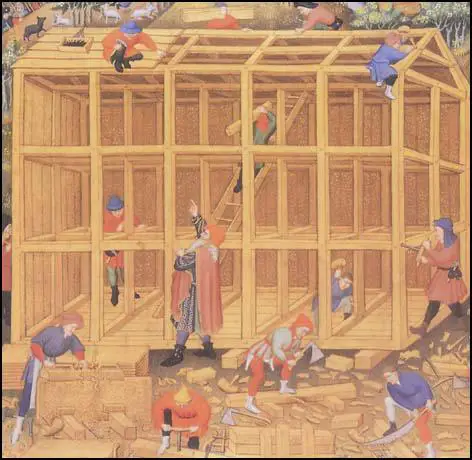Medieval Houses
Medieval houses had a timber frame. Panels that did not carry loads were filled with wattle and daub. Wattle was made by weaving twigs in and out of uprights. Hazel twigs were the most popular with Medieval builders. After the wattle had been made it was daubed with a mixture of clay, straw, cow dung and mutton fat. When it had dried, a mixture of lime plaster and cow hair was used to cover the surface and to seal the cracks.
The shaping of stone was difficult and expensive. Stones were therefore used sparingly. Stones were sometimes placed at the corners of buildings and around windows and door openings. Bricks were also very costly and in the Middle Ages they were only used to build houses for the very rich.
In the early Middle Ages most roofs were thatched. Fires were a constant problem and in 1221 a law was passed prohibiting the use of thatch. This new law stated that the roofs of new buildings had to be covered with wooden shingles, stone slabs or clay tiles. Shingles were cut by hand from local oak trees. Craftsmen travelled throughout Sussex making tiles from local clay. Shingles and tiles were fixed to oak or elm timbers by wooden pegs and were overlapped to prevent water getting into the buildings.
Most of the houses in East Grinstead were two storeys high. These houses usually had very small frontages and were sometimes only 12 feet (3.6 metres) wide. In the 14th century jetties became very popular. A jetty is where the upper floor sticks out over the one below. The overhang provided a larger room in the upper story. It also helped to protect the lower story from the weather. Traders who made a success of their business were able to build more substantial houses on the edge of the town. These houses become known as Wealden houses. Most of these houses were large with a floor area of 15 by 6 metres (50 by 20 feet).

1. Describe the type of houses that rich people in East Grinstead lived in during the 14th century. Include the following words in your answer: (bricks, sandstone, Horsham, jetty, Wealden, lime, detached)
2. Describe the type of houses that ordinary people in East Grinstead lived in during the 14th century. Include the following words in your answer: (twigs, clay, straw, mutton, thatch, shingles, lime, terraced)
3. Look closely at your house in Yalding. Describe the materials that were probably used to build your house.
